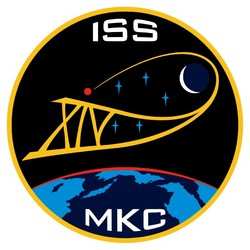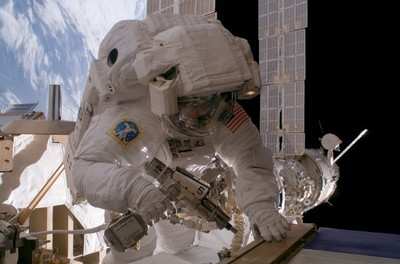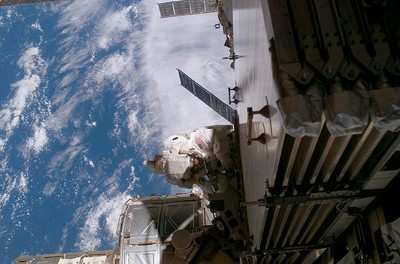 International Space Station
Commander Mike Lopez-Alegria and Flight Engineer Sunita Williams
wound up the second of a series of three spacewalks at 3:49 p.m.
EST Sunday, completing almost all scheduled tasks and one get-ahead
task. The first of the three-spacewalk series was successfully
completed Jan. 31. The third is scheduled to begin at 9 a.m. next
Thursday, Feb. 8.
International Space Station
Commander Mike Lopez-Alegria and Flight Engineer Sunita Williams
wound up the second of a series of three spacewalks at 3:49 p.m.
EST Sunday, completing almost all scheduled tasks and one get-ahead
task. The first of the three-spacewalk series was successfully
completed Jan. 31. The third is scheduled to begin at 9 a.m. next
Thursday, Feb. 8.
The first parts of the Sunday spacewalk, EVA 7, were similar to
the previous one, though crew members seemed to work through the
now-familiar tasks more smoothly. Lopez-Alegria and Williams began
the second spacewalk by reconfiguring the second of the two cooling
loops serving Destiny from the temporary to the permanent
system.
At the rats’ nest, Lopez-Alegria reconfigured the fluid
loop connections, moving the second pair of the fluid lines of the
early system from the lab and connecting them back up to the Z1
panel. That will help enable reactivation of the early cooling
system if it should be required. Williams reconfigured electrical
connections.
Next they stood by as the ground retracted the aft radiator of
the P6. After retraction they installed another set of six cable
cinches and two winch bars to secure the radiator and then
installed a shroud to cover the radiator.
The spacewalkers then completed work with the Early Ammonia
Servicer (EAS) on the P6 Truss. It provided a contingency supply of
ammonia for the Early Ammonia System. With the permanent system
working, it is no longer needed.

During the Jan. 31 spacewalk, Lopez-Alegria and Williams removed
and reconnected to a rats' nest fitting one of two lines linking
the EAS with the old cooling system. Sunday they removed the second
line and reconnected its end. Those tasks were to prepare to
jettison the EAS this summer.
Lopez-Alegria then photographed the inboard end of the P6
starboard solar wing, in preparation for its retraction during the
STS-117 mission in March.
Williams brought tools and cables to the forward end of the lab,
where Lopez-Alegria joined her. Together they worked on routing and
installation of the Space Shuttle Power Transfer System (SSPTS)
cables. They worked to reroute the SSPTS cables, a job begun on EVA
6, which will allow the shuttle to draw power from the station's
solar arrays. Three final connections will be made during the
Thursday spacewalk.
The get-ahead task completed was removal of a sunshade from a
multiplexer-demultiplexer, a data-relay device. Back in the airlock
Lopez-Alegria and Williams did some precautionary decontamination
porcedures after a few ammonia flakes were seen early in the
spacewalk.

The three spacewalks from the Quest airlock in U.S. spacesuits
and a Russian spacewalk scheduled for Feb. 22 are the most ever
done by station crew members during a single month. They also will
bring to 10 the total number of spacewalks by Lopez-Alegria, an
astronaut record. Williams will have a total of four, the most ever
by a woman.
Starting from scratch, it takes about 100 crew-member hours to
prepare for a spacewalk. By doing them a few days apart,
considerable crew time can be saved by not having to repeat some of
those preparatory steps.
 Aero-News: Quote of the Day (05.15.25)
Aero-News: Quote of the Day (05.15.25) NTSB Final Report: Avia Stroitel AC-5M
NTSB Final Report: Avia Stroitel AC-5M ANN's Daily Aero-Linx (05.15.25)
ANN's Daily Aero-Linx (05.15.25) Airborne 05.09.25: Frecce Tricolori MidAir, A6M3 Zero Returns, Houthis Bombed
Airborne 05.09.25: Frecce Tricolori MidAir, A6M3 Zero Returns, Houthis Bombed ANN's Daily Aero-Linx (05.16.25)
ANN's Daily Aero-Linx (05.16.25)





